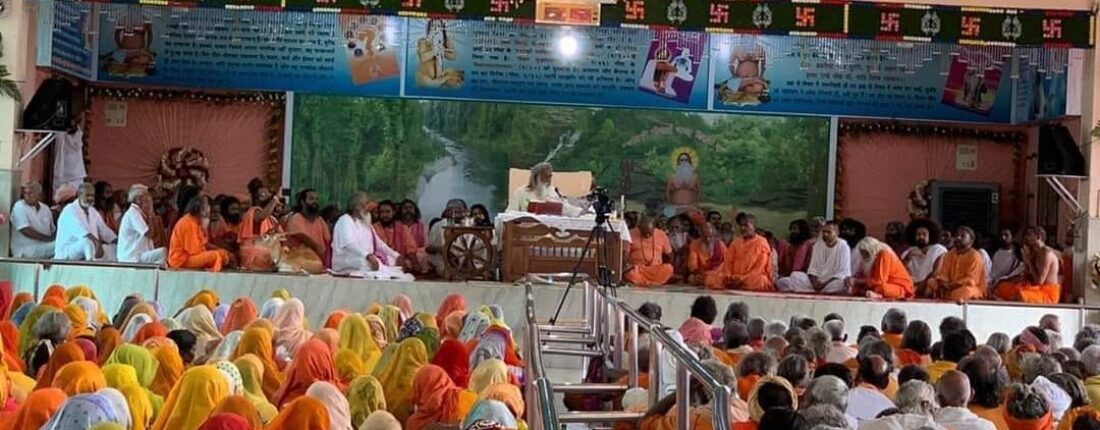A compilation of precepts of the active discipline that provides access to
the Supreme Being is what a scripture is. Having this in view, the Bhagavad-Geeta to which Sri Krishn has given utterance is a faultless treatise of the eternal, immutable Dharam and stands by itself for the four Veds, the Upanishads, the sacred theory of yog and the Ramayan as also for all the other holy books of the world.
For the entire mankind, the Geeta is an irrefutable embodiment of the
righteousness.
The Geeta is not a holy book that belongs to any one individual, caste, group, school, sect, nation or time. It is rather a scripture for the entire world and for all times. It is for all, for every nation, every race, and for every man and woman, whatever be their spiritual level and capacity. Irrespective of this, however, just hearsay or someone’s influence should not be the basis for a decision that has a direct bearing upon one’s existence.
Sri Krishn says in the last chapter of the Geeta that even just hearing its mysterious knowledge is indeed salutary. But after a seeker has thus learnt it from an accomplished teacher, he also needs to practice it and incorporate it into his own conduct and experience. This necessitates that we approach the Geeta after freeing ourselves from all prejudices and preconceived notions.
And then we will indeed find it a pillar of light.
To regard the Geeta as just a sacred book is not enough. A book is at best a sign-post that guides readers to knowledge. It is said that one who has known the truth of the Geeta is a knower of the Ved-which literally means knowledge of God. In the Upanishad Brihadaranyak, Yagnvalkya calls the Ved “The breath of the Eternal.” But all the knowledge and all the wisdom that the Geeta embodies, we must always remember, comes to consciousness only within the worshiper’s heart.

Its universality makes the Geeta unique among the eminent sacred
works of the entire world. That also makes it a yardstick by
which
the veracity of other holy books can be tested and judged.
So the Geeta is that touchstone that vindicates the substance of truth in other scriptures and also resolves disputes arising from their sometimes incompatible or even contradictory assertions. This has been seen that, almost all holy books abound in provisions for worldly life and sustenance, and also in directives for religious rites and ceremonies. There are also introduced into them-in order to make them more attractive-sensational and even dreadful accounts of what ought or ought not to be done.
It is so unfortunate that people blindly accept all these superficial matters as the “essence” of dharm, forgetting that regulations and modes of worship that have been laid down for the conduct and sustenance of physical life are bound to undergo change with place, time, and situation.
This really is behind all our communal and religious disharmony. The uniqueness of the Geeta is that it rises above temporal questions and reveals the dynamic way by which man may achieve perfection of the Self and final absolution. There is not a single verse in the whole composition that is concerned with sustenance of physical life. On the contrary, each verse of the Geeta demands of its disciples that they equip themselves and get ready for the inner war-the discipline of worship and meditation. Instead of embroiling us in the irreconcilable contradictions of heaven and hell, it is concerned exclusively with demonstrating the way by which the Soul may attain to the immortal state after which
there are no shackles of birth and death.
Instead of providing skills needed for the sustenance of worldly, mortal life, the Geeta instructs its votaries in the art and discipline that will surely bring them victory in the battle of life.
But the war the Geeta portrays is not the physical, worldly war that is fought with deadly weapons, and in which no conquest is ever of a permanent character. The war of the Geeta is the clash of innate properties and inclinations, the symbolic representation of which as “war” has been a time-honoured literary tradition.
What the Geeta portrays as a war between Dharmkshetr and Kurukshetr, between the riches of piety and the accumulation of impiety, between righteousness and unrighteousness, is no different from the Vedic battles between Indr and Vrit-between awareness and ignorance, or the Puranic struggles between gods and demons, or the battles between Ram and Ravan and between the Kaurav and the Pandav in the great Indian epics Ramayan and Mahabharat.
Geeta contains the complete description of the dynamic meditational system of the research that gives attainment to the self, which is the complete spirituality of India and also the basic source of the prevailing religions of the whole world.
It further concludes that the Supreme Being is one, the action to attain is one, the grace is one and the result too is one
and
that is the vision of Supreme Being, attainment of godliness
and
eternal life.
[Revered Swami Adgadanandji]
*******************
As expounded most revered Gurudev.
Humble Wishes!!!
 As expounded by most revered Gurudev
As expounded by most revered Gurudev 





